

|
 P e n n y G i f f o r d
P e n n y G i f f o r d
Strasser Hoofcare Professional, Certified (2004)
Holistic horse and hoofcare, short term agistment. Barefoot transition and
lameness rehabilitation. Focusing on healthy happy horses. Area covered:
Waikato, South Auckland and now also based in Kumeu.
Ph 07 884 8773 Te Aroha, or 09 4122308 Kumeu, M 0272526090, Email: barefootrocks@clear.net.nz
 About Penny Gifford
About Penny Gifford
My passion and love for horses started many years ago as a child, but my
inspiration to follow Holistic Horse and Hoofcare began when I attended a
three-day clinic with Todd Merrell from the USA, one of Dr Hiltrud Strasser's
instructors in Holistic Horse and Hoofcare.
I wanted to gain the knowledge and skills to be able to keep my horses as healthy
and happy as possible in a domestic environment. I had seen many horses become
lame or unwell with a variety of diseases which usually resulted eventually in
euthanasia.
Hoofcare Qualifications
Attending Todd Merrell's clinic was an eye opener for me, and at the end of it,
I learned there was the possibility of becoming a qualified Strasser Holistic
Hoofcare Professional. I couldn't let go of the idea that this is what I had
been looking for, so followed up and enrolled. This was a huge commitment for me
time wise and financially to return to study at age 45 but after 18 months hard
work, I passed my final exams with six other like-minded New Zealaders, the
first Kiwis to qualify.
During my study we were required to have case studies to present at the final
exams. Some people had contacted me to help with hoofcare for their horses, and
most of them had some degree of hoof and health problems with their horses. So
they were briefed on the requirement for Holistic Hoofcare and I continue to
help these people and their horses to this day with great success.
What is Holistic Horse and Hoofcare?
My training is to understand the functions of a healthy hoof and natural environment to best
work with horse owners to achieve a healthy sound horse able to perform in
any discipline barefoot.
Two of the most important aspects is movement (15km per day) on
breed-appropriate terrain, combined with a correct physiological hoof form for
optimal hoof mechanism or expansion of the hoof. This gives optimal circulation
to the hoof, which in turn gives optimal quality hoof growth in order for the
horse to be sound and capable of the tasks required from them.
In nature, hoof growth and hoof wear are in balance. In a domestic situation,
this is altered, depending on the environment we provide. I see it as our
responsibility to do our best to provide a healthy holistic environment for horses to live a
long and healthy natural lifespan. We can do this by gaining knowledge about the best
possible practice to replicate nature in a domestic situation.
Movement, hoofcare, nutrition, herdlife, shelter and comfortable equipment that
does not cause physical pain. It is also important to learn to understand the
horse's mind, so that we can safely work with the horse for mutual enjoyment
As part of my work with hoofcare, I am also very interested in supportive natural
therapies to support healing and restoration to health of horses with problems.
Penny's Success Stories
Harlequin
My own horse Harlequin, who I bought as a very green three-year old, is now 17
(2007). He was shod until I discovered barefoot when he was 12 years old, which
had resulted in severe contraction of his hooves. After applying the Strasser
Method, Harlequin has extremely strong quality hooves and can now go just about anywhere he is
conditioned for on his barefeet, including beach and forestry rides, jumping and
hunting.
|
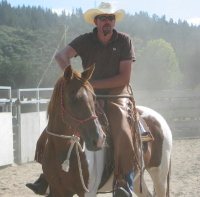
|
Shadow
I bought Shadow, a grey registered Arab, as a three year old, he had a natural lifestyle on the stud
where he was bred but hadn't had any hoofcare that I know of. He was given a
natural trim and environment in the company of other horses and was led out from
an older horse around the roads and slowly started to be educated with ground
work. Then he was professionally started by Russell Higgins, PNH, and then
hacked out bitless to include experiences such as beach riding, fun endurance rides,
road rides etc on as many different terrains as possible. Though he arrived with
a toe crack and slight club in his off fore hoof, and some quite bad flaring on
all hooves, these problems were quickly remedied using the Strasser Method and
he has remained sound over all terrain since.
|
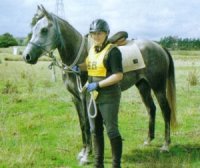
|
Dusty, the donkey
Dusty is a 23-year-old donkey who could barely walk due to and incorrect
living conditions and incorrect hoofcare, resulting in very overgrown and deformed hooves.
Penny Gifford has been trimming Dusty's hooves and advising his owners of the Strasser
Method of care since December, 2004. He is now much more comfortable and enjoys his
walks. click here for a full article about Dusty's case study and the
care of donkeys.
|
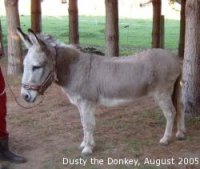
|
Missy
Missy was an aged pony (late 20s) with severely contracted hooves, some coffin bone
rotation and Cushings symptoms when the Strasser Method was first applied. With the Strasser
Method, Missy became more sound, the signs of Cushings disappeared, and she continued to take seven and eight year olds to pony club. She has the free range
of 10 acres with two other horses and access to a stream. Her owner describes her as being
200 percent better since using the Strasser Method and is happier and healthier than she has
ever been.
|

|
The Real McCoy
The Real McCoy, or "Mac", an ex-racehorse, who came to us in very poor condition, with four very brittle white hooves
and a host of unsociable behaviours, including extreme nervousness when out. With the
Strasser Method, and a good natural environment
including herd life, Mac soon became completely sound over all terrain, with hard, good
quality hooves, and his temperament improved to a mellow, safe ride we could happily take
anywhere bitless and barefoot: jumping, hunting, beach rides, hacking out in groups etc.
|
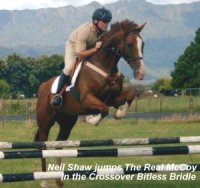
|
Dodge
A stunning warmblood that became lame while shod, to be diagnosed with
incurable navicular in January 07. Conventional veterinary recommendations at that
time were euthanasia, or an operation which would keep horse usable for a short
period of time, then euthanasia.
After Strasser barefoot trimming in April 08, Dodge became sound, and was placed in dressage
at four outings during transition from shod to barefoot. He then continued to successfully
compete eventing barefoot and has now been leased to a dressage rider and is
competing at Elementary level, winning or being placed at nearly every
outing.
Removing the pain in the horse's heels through deshoeing and Strasser Trimming
has resulted in exceptional movement, with the horse happy to weight his heels
and fully drop the fetlock, resulting in a very free shoulder. This has contributed to his success in dressage.
A note from Dodge's rider, April 2009: "Dodge is really good,
last weekend he got a 5th and a 2nd at Woodhills Sands, and today out at Papatoetoe (Manukau Dressage Autumn Series) he got a 5th then a
1st = which we were absolutely thrilled with! His feet are really good, and we noticed that when he walked on the
gravel, he wasn't at all ouchy. Definitely the daily soaking and good foot work is paying off! He's having a
break Easter weekend (no competing) but on again on the 19th April."
|
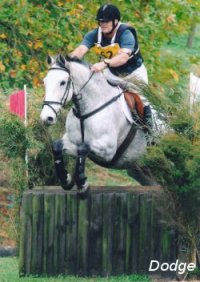
|
Mushroom
Successful Strasser trimming of a Miniature Horse, 5yrs old (2008) for 4
yrs. Mushroom is kept on a track system with big horses, including a 17.2hh
clydeX. He has never foundered, has great sound hooves and is a healthy happy
chappy.
|

|
For more information, contact Penny Gifford: Ph 07 884 8773, or 09
4122308 Kumeu, M 0272526090, Email: hartland1@ihug.co.nz
Home | Articles | Hoof Trimmers | Clinics-Events | Brag | Classifieds |
Order | Links


|
|
|




